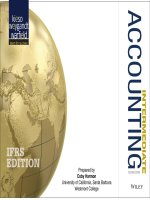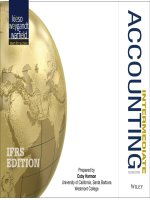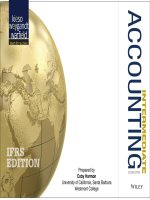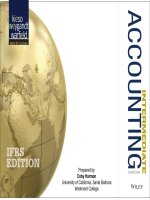Lecture Intermediate accounting (IFRS/e) - Chapter 20: Accounting changes and error
Bạn đang xem bản rút gọn của tài liệu. Xem và tải ngay bản đầy đủ của tài liệu tại đây (1.62 MB, 42 trang )
Chapter 20
ACCOUNTING
CHANGES AND
ERROR
McGrawHill/Irwin
© 2013 The McGraw-Hill Companies, Inc.
Accounting Changes
Type of Change
Description
Examples
Change in Accounting Change from one generally Adopt a new IFRS standard.
accepted accounting policy to Change method of inventory costing.
Policy
another.
Change from fair value accounting to
equity method, or vice versa.
Change in Accounting
Revision of an estimate
Estimate
because of new information
or new experience
Change from cost method to revaluation,
or vice versa.
Change depreciation methods.
Change estimate of useful life of
depreciable asset.
Change estimate of residual value of
depreciable asset.
Change estimate of impairment loss
Change actuarial estimates pertaining to
a pension plan.
20 - 2
Correction of an Error
Type of Change
Error correction
Description
Correction of an error caused
by a transaction being
recorded incorrectly or not at
all
Examples
Mathematical mistakes.
Inaccurate physical count of inventory.
Application of the cash basis of
accounting in place of the accrual basis.
Failure to record an adjusting entry.
Recording an asset as an expense, or
vice versa.
20 - 3
Accounting Changes
and Error Corrections
Retrospective
Retrospective
Two
Reporting
Approaches
Prospective
Prospective
20 - 4
Error Corrections and
Most Changes in Policies
Retrospective
Retrospective
Revise
prior
Two
Revise
prior years’
years’ statements
statements (that
(that are
are
presented
for
Reporting
presented
for comparative
comparative purposes)
purposes) to
to reflect
reflect
the
impact
Approaches
the
impact of
of the
the change.
change.
•• The
The balance
balance in
in each
each account
account affected
affected is
is revised
revised to
to
appear
appear as
as ifif the
the newly
newly adopted
adopted accounting
accounting policy
policy
had
had been
been applied
applied all
all along
along or
or that
that the
the error
error had
had
Prospective
Prospective
never
never occurred.
occurred.
•• Adjust
Adjust the
the beginning
beginning balance
balance of
of retained
retained earnings
earnings
for
for the
the earliest
earliest period
period reported.
reported.
20 - 5
The Retrospective Approach
Prior period errors must be corrected retrospectively so as to
produce correct comparative information in the current set of
financial statements
A retrospective application of a policy While a retrospective restatement of
is a retrospective adjustment to effect the comparative information is used to
a change in policy
correct a prior period error
In normal circumstances, only one year’s comparative information needs to be
provided. But, when a company makes one of the above two retrospective
adjustments, it has to present an additional statement of financial position as
at the beginning of the earliest period presented
Since the earliest period presented in a normal situation is the previous
period, the beginning of the earliest period would be two periods before the
current period
20 - 6
Changes in Estimates
The change is implemented in the Retrospective
current
Retrospective
period, and its effects are reflected in the
financial statements of the current and
future Two
years only.
• Prior years’ statements are not revised.
Reporting
• Account balances are not revised.
Approaches
Prospective
Prospective
20 - 7
Change in Accounting Policy
Qualitative
Characteristics
Consistency
Comparability
Although consistency and comparability are desirable,
changing to a new policy sometimes is appropriate.
20 - 8
Change in Accounting Policy
Accounting standards present some choices to
companies with respect to accounting policies.
20 - 9
Motivation for Accounting Choices
Effect on
on
Effect
Compensation
Compensation
Changing
Changing
Conditions
Conditions
Motivations
Motivations
for Change
Change
for
20 - 10
Effect on
on Debt
Debt
Effect
Agreements
Agreements
Effect on
on Union
Union
Effect
Negotiations
Negotiations
New Accounting
Accounting
New
Standard Issued
Issued
Standard
Effect on
on
Effect
Income Taxes
Taxes
Income
Retrospective Approach
Most Changes in Accounting Policies
Let’s look at an examples of a change from Weighted
Average (WA) costing method to the FIFO method.
At the beginning of 2012, Air Parts Corporation changed from
WA to FIFO. Air Parts has paid dividends of $40 million each
year since 2004. Its income tax rate is 20 percent. Retained
earnings on January 1, 2010, was $700 million; inventory
was $500 million. Selected income statement amounts for
2012 and prior years are (in millions):
Cost of goods sold (WA)
Cost of goods sold (FIFO)
Difference
Revenues
Operating expenses
20 - 11
Previous
2012
2011
2010
Years
$
430 $
420 $
405 $
2,000
370
365
360
1,700
$
60 $
55 $
45 $
300
$
950 $
230
900 $
210
875 $
205
4,500
1,000
Revise Comparative Financial
Statements
For
For each
each year
year reported,
reported, Air
Air Parts
Parts makes
makes the
the comparative
comparative
statements
statements appear
appear as
as ifif the
the newly
newly adopted
adopted accounting
accounting
method
method (FIFO)
(FIFO) had
had been
been in
in use
use all
all along.
along.
Income Statements ($ in millions)
Revenues
Cost of goods sold (FIFO)
Operating expenses
Income before tax
Less: Income tax expense (20%)
Net income
2012
2011
2010
$
950 $
900 $
875
370
365
360
230
210
205
$
350 $
325 $
310
70
65
62
$
280 $
260 $
248
Note: only two periods need to be reported for statements, with the exception
of the statement of financial position.
20 - 12
Revise Comparative Financial
Statements
For
For each
each year
year reported,
reported, Air
Air Parts
Parts makes
makes the
the comparative
comparative
statements
statements appear
appear as
as ifif the
the newly
newly adopted
adopted accounting
accounting
method
method (FIFO)
(FIFO) had
had been
been in
in use
use all
all along.
along.
Cost of goods sold (WA)
Cost of goods sold (FIFO)
Difference
Previous
2012
2011
2010
Years
$
430 $
420 $
405 $
2,000
370
365
360
1,700
$
60 $
55 $
45 $
300
Comparative statements will report 2010 inventory $345
million higher than it was reported in last year’s statements.
Retained earnings for 2010 will be $276 million higher.
[$345 million × (1 – 20% tax rate)]
20 - 13
Revise Comparative Financial
Statements
For
For each
each year
year reported,
reported, Air
Air Parts
Parts makes
makes the
the comparative
comparative
statements
statements appear
appear as
as ifif the
the newly
newly adopted
adopted accounting
accounting
method
method (FIFO)
(FIFO) had
had been
been in
in use
use all
all along.
along.
Cost of goods sold (WA)
Cost of goods sold (FIFO)
Difference
Previous
2012
2011
2010
Years
$
430 $
420 $
405 $
2,000
370
365
360
1,700
$
60 $
55 $
45 $
300
Comparative statements will report 2011 inventory $400
million higher than it was reported in last year’s statements.
Retained earnings for 2011 will be $320 million higher.
[$400 million × (1 – 20% tax rate)]
20 - 14
Revise Comparative Financial
Statements
For
For each
each year
year reported,
reported, Air
Air Parts
Parts makes
makes the
the comparative
comparative
statements
statements appear
appear as
as ifif the
the newly
newly adopted
adopted accounting
accounting
method
method (FIFO)
(FIFO) had
had been
been in
in use
use all
all along.
along.
Cost of goods sold (WA)
Cost of goods sold (FIFO)
Difference
Previous
2012
2011
2010
Years
$
430 $
420 $
405 $
2,000
370
365
360
1,700
$
60 $
55 $
45 $
300
Comparative statements will report 2012
inventory $460 million higher than it would have
been if the change from WA had not occurred.
20 - 15
Retained earnings for 2012 will be $368 million higher.
[$460 million × (1 – 20% tax rate)]
Adjust Accounts for the Change
On
On January
January 1,
1, 2012,
2012, the
the date
date of
of the
the change,
change,
the
the following
following journal
journal entry
entry would
would be
be made
made
to
to record
record the
the change
change in
in Policy.
Policy.
January 1, 2011:
Inventory .......................................................
Retained earnings ...............................
Deferred tax liability……….………..….
To increase inventory, retained earnings, and deferred tax liability
as a result of the change from weighted average to FIFO.
400,000,000
320,000,000
80,000,000
20% of $400,000,000
20 - 16
Disclosure Notes
20 - 17
Prospective Approach
Some Changes in Policies
Most changes in policies are reported by the retrospective
approach, but:
Sometimes aa lack
lack of
of information
information makes
makes itit impracticable
impracticable to
to
Sometimes
report aa change
change retrospectively
retrospectively so
so the
the new
new policy
policy is
is
report
simply applied
applied prospectively.
prospectively. For
For example:
example:
simply
US company
company switching
switching from
from FIFO
FIFO to
to LIFO
LIFO may
may not
not have
have kept
kept records
records of
of
••AAUS
the required
required information
information to
to restate
restate past
past periods.
periods.
the
company adopting
adopting the
the fair
fair value
value option
option for
for an
an amortized
amortized cost
cost debt
debt
••AAcompany
instrument would
would not
not be
be able
able to
to fathom
fathom the
the manager’s
manager’s intent
intent in
in past
past
instrument
periods.
periods.
company moving
moving to
to adopt
adopt the
the fair
fair value
value model
model for
for its
its investment
investment
••AAcompany
properties (which
(which are
are thinly
thinly traded)
traded) would
would not
not be
be able
able to
to guess
guess what
what their
their
properties
discounted cash
cash flow
flow projections
projections would
would have
have been
been like
like in
in the
the past
past periods.
periods.
discounted
20 - 18
Prospective Approach
Some Changes in Policies
20 - 19
Prospective Approach
Some Changes in Policies
Most changes in policies are reported by the retrospective
approach, however:
There is
is another
another exception
exception to
to retrospective
retrospective application.
application.
There
That is
is when
when an
an IASB
IASB Statement
Statement or
or another
another authoritative
authoritative
That
pronouncement requires
requires prospective
prospective application
application for
for
pronouncement
specific changes
changes in
in accounting
accounting policies
policies::
specific
The entity
entity is
is required
required to
to follow
follow the
the IFRS
IFRS prescribed
prescribed transitional
transitional
•• The
provisions when
when itit first
first applies
applies the
the changes
changes in
in aa new
new or
or amended
amended
provisions
standard.
standard.
In certain
certain instances,
instances, prospective
prospective application
application of
of the
the new
new IFRS
IFRS is
is
•• In
required.An
An example
example would
would be
be the
the implementation
implementation of
of IFRS
IFRS No.
No. 3,
3,
required.
“Business Combinations”.
Combinations”.
“Business
20 - 20
Prospective Approach
Change in Accounting Estimate
A change in depreciation method is not a
change in policy but a change in the
expected pattern of consumption of
benefits of an asset, therefore, we
account for such a change
prospectively; that is, precisely the
way we account for changes in
estimates.
Note: A disclosure note should describe
the nature and effect of the change in the
accounting estimate in the current as
well as future periods affected by the
change. If the amount of effect in future
periods could not be determined, the
company should disclose that fact.
20 - 21
Change in Accounting Estimate
Changes in accounting estimates are accounted for
prospectively. Let’s look at an example of a change in a
depreciation estimate.
On January 1, 2008, Towing Ltd purchased specialized
equipment for $243,000. The equipment has been
depreciated using the straight-line method and had an
estimated life of 10 years and salvage value of $3,000. At
the end of 2011 the total useful life of the equipment was
revised to 6 years. Calculate the 2012 depreciation expense.
$243,000 – $3,000 = $24,000 (2008 – 2011)
10 years
$24,000 × 4 years = $96,000 Accum. Depr.
$243,000 – $96,000 = $147,000 Book Value
$147,000 – $3,000 = $72,000 (2012 & 2013)
2 years
20 - 22
Changing Depreciation Methods
Universal
Universal Semiconductors
Semiconductors switched
switched from
from SYD
SYD
depreciation
depreciation to
to straight-line
straight-line depreciation
depreciation in
in 2012.
2012.
The
The asset
asset was
was purchased
purchased at
at the
the beginning
beginning of
of 2010
2010
for
for $63
$63 million,
million, has
has aa useful
useful life
life of
of 55 years
years and
and
an
an estimated
estimated residual
residual value
value of
of $3
$3 million.
million.
Sum-of-the-Years-Digits Depreciation (millions)
2010 depreciation
2011 depreciation
Accumulated depreciation
20 - 23
$ 20
16
$ 36
($60 x 5/15)
($60 x 4/15)
Changing Depreciation Methods
Calculation of Straight-Line Depreciation ($ in millions)
Asset's cost
Less accumulated depreciation to date of change
Undepreciated cost on January 1, 2012
Less estimated residual value
To be depreciated over remaining three years
Remaining life
Annual straight-line depreciation (2012-2014)
20 - 24
$ 63
36
$ 27
3
$ 24
÷ 3 years
$ 8
Changing Depreciation Methods
Depreciation
Depreciation adjusting
adjusting entry
entry
for
for 2012,
2012, 2013,
2013, and
and 2014.
2014.
Depreciation expense ...................................
Accumulated depreciation ..................
To record depreciation expense.
20 - 25
8,000,000
8,000,000









